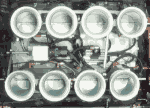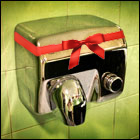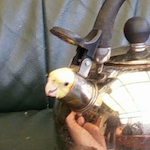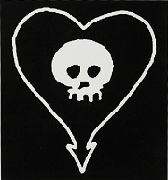|
jonathan posted:So can gasolene just not be kept from preignition under those conditions ? Not easily, no. The charge air heats up enough under than compression to ignite the gasoline before the spark fires. Direct injection is helping with this as it will inject the fuel very late in the compression cycle, so the heat of the charge air has a lesser effect on it. Higher octane rating, water injection to reduce compression charge temps, there are a few methods to aid this but untilmately it's limited by the fuel's flashpoint. Gasoline pre-igniting isn't nearly as efficient as spark-igniting, so even direct injection can only do so much. It's not much use if the fuel ignites as it's injected before the spark fires.
|
|
|
|

|
| # ? Apr 25, 2024 10:23 |
|
You will have the same emissions problem as diesels do - high NOx levels. The current crop of DI gas engines are already borderline non-compliant and will certainly need urea injection just like diesels do as emissions standards tighten. EDIT: Aww yiss malaise era 2.0 here we come. 8.0l 130hp V8s are back on the menu boys Throatwarbler fucked around with this message at 09:06 on Jun 7, 2015 |
|
|
|
I'll eventually get around to posting some content here. I just moved to a new state and started my first job out of engineering school, working for the Navy / DoD. It owns!
|
|
|
|
Party Alarm posted:I'll eventually get around to posting some content here. I just moved to a new state and started my first job out of engineering school, working for the Navy / DoD. It owns! Cool! Hopefully working on the Navy's fun little rail gun!
|
|
|
|
Just curious, Kastein mentioned cool new LIN bus Bosch wiper motors in the Das Volk free Viper Appreciation Station. Is there any way for a pleb such as myself to get ahold of products like that from Bosch without tracking down an application vehicle and buy parts for it? Is there such a thing as a reference design sold on the open market? This may be wishful thinking, but it sure would be cool to get things like that and the teeny tiny fuel injectors they make for small engines. I've been curious where I could get some of those for some time.
|
|
|
|
Commodore_64 posted:Just curious, Kastein mentioned cool new LIN bus Bosch wiper motors in the Das Volk free Viper Appreciation Station. Is there any way for a pleb such as myself to get ahold of products like that from Bosch without tracking down an application vehicle and buy parts for it? Is there such a thing as a reference design sold on the open market? This may be wishful thinking, but it sure would be cool to get things like that and the teeny tiny fuel injectors they make for small engines. I've been curious where I could get some of those for some time. Not sure if they have some kind of catalogue, but if you have a Bosch part number any Bosch distributor can order parts in for you. I often order connects, rubber boots and other wiring products through Bosch distributors.
|
|
|
|
Commodore_64 posted:Just curious, Kastein mentioned cool new LIN bus Bosch wiper motors in the Das Volk free Viper Appreciation Station. Is there any way for a pleb such as myself to get ahold of products like that from Bosch without tracking down an application vehicle and buy parts for it? Is there such a thing as a reference design sold on the open market? This may be wishful thinking, but it sure would be cool to get things like that and the teeny tiny fuel injectors they make for small engines. I've been curious where I could get some of those for some time. Since Mooseykins posted what he did... Datasheet: http://www.bosch-motorsport.com/media/catalog_resources/Wiper_Direct_Actuator_WDA_Datasheet_51_en_2785939211pdf.pdf This gives the mating connector, motor (analog and LIN variants) and other part numbers. Application (for cheap OEM replacement, ebay, junkyard, etc sourcing instead of $rape pricing via Bosch Motorsport) is 2012+ Ford Focus. Wiring diagram for same vehicle is at http://www.revbase.com/BBBMotor/Wd/DownloadPdf?id=1009599 Part numbers on rockauto are Motorcraft WM797 (right, brand new) WM799 (right, reman) and WM796 (left, brand new). Expect to pay around $240 for a pair brand new including core charges. I got a set for like $120 on ebay for prototyping purposes about 6 months ago.
|
|
|
|
Heh Heh. Need a carb recommendation for a draw-through turbo setup I'm designing. Draw through is almost irrelevant except might need a built in electric warmer. It will be going on a 2008 Kawasaki Teryx that I have. 840cc, V-twin, 4 valves per cylinder. Makes around 75hp right now, I want to run around 15 psi of boost to get around 150hp out of it at 8500rpm. Some calculators recommend a 144cfm carb. I will be using shell premium 92 octane fuel and a water/meth injection after the turbo to cool the air charge. So, what carb companies should I start looking at for smaller carbs ? Most of the race applications use smaller carbs, one per cylinder, including this Teryx. It uses 2 34mm Keihin slide carbs.
|
|
|
|
Way late to the party - but I'd almost try something like a Harley CV (aka Keihin CV40, or CVK40 if it's on a Kawasaki) or a 48mm Mikuni. If you look at some applications they're put on, it may look too small, but normally bikes and ATVs do one carb per cylinder so most of the time the carb doesn't have any flow through it - while a turbo is going to be sucking through it all the time and should be able to make a lot more power per a given carb size. SUs are automotive carbs that were in a lot of things and are pretty much the same thing, but I don't know what the odds of getting good ones anymore is. Oh yeah, hi, I'm an engineer currently working at an R&D lab for a small engine (think riding lawnmower size) manufacturer.
|
|
|
|
Oh cool, this is a thread that exists. Is there any data public on the study of tire grip vs camber angle? I'd like to make a calculator of sorts where I can plug in specific suspension set ups and get rough performance metrics out.
|
|
|
|
Well, it'll be highly dependent on the tire itself. I'm not sure you'd find data that specific easily, but it might exist somewhere.
|
|
|
|
Party Alarm posted:Well, it'll be highly dependent on the tire itself. I'm not sure you'd find data that specific easily, but it might exist somewhere. Any tire will do, I just want to see if the trend is linear or exponential. Some sort of base equation.
|
|
|
|
um excuse me posted:Oh cool, this is a thread that exists. Is there any data public on the study of tire grip vs camber angle? I'd like to make a calculator of sorts where I can plug in specific suspension set ups and get rough performance metrics out. There are some charts in RCVD and Pacejka's tire dynamics book, I'll try to dig them up later. Cliff notes are that you are going to continue to increase cornering grip well past the point of hindering braking performance and having way uneven tire temps. Best way to dial in alignment (and tire pressure, and suspension balance) is with a tire pyrometer.
|
|
|
|
I don't think there is anything that simple TBH. You get the most grip when you have the largest contact patch, and that happens at a certain slip angle because tires deform. Camber is dynamic too - it changes as suspension compresses and extends with body roll in a corner, and also with steering angle. What you're looking for is what amount of camber gets you the maximum amount of contact patch around a given corner, and it's really more dependent on suspension geometry than the tire itself. I don't think there's a good simple answer for you. Go look up camber curves and how to calculate them - you may find it pretty interesting! I'm no expert on suspension design though, so hopefully some others will chime in. e: ^^^ like that!
|
|
|
|
Avon is the only company I know of that publishes data where ordinary people can get it - more or less everyone else will only give you data if you're shelling out gigantic bucks. Check out http://www.avonmotorsport.com/resource-centre/downloads for some example stuff; what you want is what they call the stability rig data. It is very tire dependent, but there's lots of models to approximate stuff. Have fun, but know that there's tools out there available for not stupid money to do the same sort of simulation you're thinking of. Dynatune XL looks really interesting, though I haven't shelled out yet.
|
|
|
|
There are some interesting free suspension calculators out there as well, like this one which is interesting to play with to visualize how things work. It calculates some neat stuff like bump steer too.
|
|
|
|
You're also going to need to consider sidewall stiffness, tire pressure, vehicle weight, whether it's a radial or bias ply tire, and even the specific tire design in question. And for that matter bushing deflection in the suspension and weight transfer, when you really get down to it.
|
|
|
|
Thanks for the information. When I make these excel calculators (first one for a car), I always start off pretty basic. Assume a bunch of variables like kastein mentions and test the calculator to find bugs and messed up equations. Once it's relatively stable, I will start adding variables and other inputs. Eventually I want to get to the point where I'm taking data samples from my car and cross comparing them to the calculator and make adjustments to various constants to better approximate the way my car would perform beyond theory, which is the end goal. All tire companies have their trade secrets regarding chemistry composition and tire construction, so it'll never be perfect. But if I can within a couple of percent accuracy, I'll be happy.
|
|
|
|
Main thing to be concerned with is the relationship between force, load, and slip angle. The details of the tire itself are super complex. Here's a chart from racecar vehicle dynamics, the classic textbook about this kind of stuff:  Makes it clear why increasing the weight transfer on one end via spring rate will reduce traction. More spring rate means more proportional weight transfer which means more load on that tire. Even though more normal force should mean more friction, a tire is not an ideal block of rubber. So here is cornering force vs camber angle for a few different loads:  Optimum camber is really dependent on the load and tire. More load and cornering force generally means you want more camber. The notes for that graph mention that the 400lb plot is probably inaccurate. They also said that the max force increase happened at 1200lb at -6 degrees of camber, where there was a 6% increase in traction. On the other hand, once you get to about -4 you start to really compromise longitudinal grip and tire life. I think that will at least give you an idea of how the traction changes based on load and camber, but of course it is tire dependent. Also note that these are actual numbers between the tire and the ground. In reality, on a car that is leaned over and cornering, you are lucky to get the tire even at zero. So even if you are cooking the insides of the tires, the car will probably still go faster. Probably a worthy sacrifice for anything short of endurance racing. jamal fucked around with this message at 06:55 on Feb 5, 2016 |
|
|
|
Oh yeah, something I realized at my last job - even among pretty technically minded car guys, there's not a hell of a lot of understanding on how/why fluid film bearings work and how they fail. I thought about doing a low to no math explanation with some lovely drawings for illustration; would anyone care?
|
|
|
|
jamal posted:Also note that these are actual numbers between the tire and the ground. In reality, on a car that is leaned over and cornering, you are lucky to get the tire even at zero. So even if you are cooking the insides of the tires, the car will probably still go faster. Probably a worthy sacrifice for anything short of endurance racing. mekilljoydammit posted:Oh yeah, something I realized at my last job - even among pretty technically minded car guys, there's not a hell of a lot of understanding on how/why fluid film bearings work and how they fail. I thought about doing a low to no math explanation with some lovely drawings for illustration; would anyone care?
|
|
|
|
mekilljoydammit posted:Oh yeah, something I realized at my last job - even among pretty technically minded car guys, there's not a hell of a lot of understanding on how/why fluid film bearings work and how they fail. I thought about doing a low to no math explanation with some lovely drawings for illustration; would anyone care? Does this help? http://www.machinerylubrication.com/Read/779/journal-bearing-lubrication
|
|
|
|
slidebite posted:Do you mean a plain/journal bearing? I am a CBS (certified bearing specialist) and while those are certainly not my strong suit, they work about as simply as you think they do - the rotating shaft is separated from the bearing surface by a layer of lubricant. Failures almost always happen due to wear on start up/shut down before the film layer is built up/disappears or debris gets in the lubrication system which also breaks the layer, which causes more debris, etc. There are technical tables for selection and oil lubrication recommendations. I believe you misunderstand. I spent the last couple years as a test engineer in an R&D lab for a fluid film (what you're calling plain bearings, yeah) bearing manufacturer - they're not quite as simple as you'd think when you start pushing things, and in development, we were. Even weirder, because of a variety of factors, reciprocating engines don't follow any of the normal industry sizing stuff - if you look at peak cylinder pressure on turbocharged engines, and do math on bearing unit loads, it shouldn't work. And some engine designs (I'm looking at you here, Subaru) really really push things. I was going to finally sit down with a couple textbooks and do some math to figure out how marginal Subaru bearings really are and I was more curious if anyone would be interested in a crash course.
|
|
|
|
NitroSpazzz posted:This is pretty much what we found on the endurance car but E30's love camber. We run as much camber as physically possible while still allowing us to finish the race without the inside of the tire showing chord. Highly track and even driver based though so it gets tricky. We're looking at bending the drat shock towers and struts to get more negative in front, the rear is pretty happy. On the other hand, that tire test data is from like 1990 for a 225/70-15. A modern wide, low profile tire is probably not going to like as much camber.
|
|
|
|
jamal posted:On the other hand, that tire test data is from like 1990 for a 225/70-15. A modern wide, low profile tire is probably not going to like as much camber. We're still destroying the outside edge first by a big margin so we're doing everything we can to add. Only sitting at around -3.5 degrees (front) right now if I'm remembering right.
|
|
|
|
mekilljoydammit posted:I was going to finally sit down with a couple textbooks and do some math to figure out how marginal Subaru bearings really are and I was more curious if anyone would be interested in a crash course. 
|
|
|
|
mekilljoydammit posted:I believe you misunderstand. I spent the last couple years as a test engineer in an R&D lab for a fluid film (what you're calling plain bearings, yeah) bearing manufacturer - they're not quite as simple as you'd think when you start pushing things, and in development, we were. Even weirder, because of a variety of factors, reciprocating engines don't follow any of the normal industry sizing stuff - if you look at peak cylinder pressure on turbocharged engines, and do math on bearing unit loads, it shouldn't work. And some engine designs (I'm looking at you here, Subaru) really really push things. Gotcha, understand where you are coming from. I've only dealt with them on the industrial side and even then never in ICE. I suspect you already know far more about them than I do.
|
|
|
|
mekilljoydammit posted:if you look at peak cylinder pressure on turbocharged engines, and do math on bearing unit loads, it shouldn't work. And some engine designs (I'm looking at you here, Subaru) really really push things. Answer: very NoiseComplaint and I went junkyarding some time ago and walked through the Subaru section. Five EJ251 cars in a row had thrown their #1 rod through the top of the block. http://www.superstreetonline.com/how-to/engine/impp-1103-subaru-ej-series-engine-tech/ I would love to see the math and understand how you're supposed to size them, however.
|
|
|
|
Speaking of turbocharged engines, I'd be happy to answer any hydrodynamic/fluid film bearing questions as they relate to turbos since that's part of what I do at work. poo poo gets pretty crazy when you're constantly operating above the first critical speed and often shooting past the fifth, our smaller turbos spin upwards of 300,000 RPM with exhaust gas temperatures over 1000°C.
|
|
|
|
As the owner of a Subaru with rod knock, I'd love to see a post on bearing sizes and selection and how badly Subaru hosed the dog on them. (a whole lot, is my guess)
|
|
|
|
Our race car did not ever have bearing problems, but the oiling system was a bit modified. Wider oil pump rotors, accusump, big pan, accurately measured clearances, and billet cranks with different oil passages. And very little knock. On the other hand, when you compare a wrc crank and bearing sizes to OEM there is a big difference.
|
|
|
|
MonkeyNutZ posted:exhaust gas temperatures over 1000°C. Please don't do this, you break O2 sensors 
|
|
|
|
mekilljoydammit posted:I believe you misunderstand. I spent the last couple years as a test engineer in an R&D lab for a fluid film (what you're calling plain bearings, yeah) bearing manufacturer - they're not quite as simple as you'd think when you start pushing things, and in development, we were. Even weirder, because of a variety of factors, reciprocating engines don't follow any of the normal industry sizing stuff - if you look at peak cylinder pressure on turbocharged engines, and do math on bearing unit loads, it shouldn't work. And some engine designs (I'm looking at you here, Subaru) really really push things. This just reminded me that we spend a really long time on journal bearings in school and zero time on roller/ball bearings. In retrospect my engineering program was terrible in so many ways  Would definitely like to see some calcs though.
|
|
|
|
totalnewbie posted:Please don't do this, you break O2 sensors All you have to do is put the O2 sensor further downstream  The LSU-4.9 is rated for 1030C absolute max temp, so a foot or two from the turbo should be plenty. That's probably also 1000C intake-to-turbine temp and quite a bit of temp is lost across the turbine. mekilljoydammit posted:I was going to finally sit down with a couple textbooks and do some math to figure out how marginal Subaru bearings really are and I was more curious if anyone would be interested in a crash course. I would read the poo poo out of this.
|
|
|
|
totalnewbie posted:Please don't do this, you break O2 sensors Kinda have to nowadays for fuel economy (smaller displacement boosted stuff). The higher allowable temperature limit of the turbo, the less enrichment needed to cool things down = better fuel economy.
|
|
|
|
NitroSpazzz posted:This is pretty much what we found on the endurance car but E30's love camber. That kind of goes for BMWs in general because McPherson strut front suspension has pretty poor camber gain on compression, and you want camber gain to keep maximum contact patch while the car rolls mid corner
|
|
|
|
mekilljoydammit posted:I was going to finally sit down with a couple textbooks and do some math to figure out how marginal Subaru bearings really are and I was more curious if anyone would be interested in a crash course. As the owner of a stock 2015 STI with a god drat rod knock at 17,000 miles...please...do tell EDIT: BTW I am a mech eng so would love to see Subaru/EJ25 specific calculations if you have them. CarForumPoster fucked around with this message at 04:25 on Feb 8, 2016 |
|
|
|
I had mentioned the wrc Subaru engines had larger bearings but that's actually not true. Same crank journal diameters (60mm main, 52mm rod if anyone was wondering). I would actually not blame the bearing size specifically, although I'm definitely interested in what mekilljoy has to say. I would blame most failures on oil starvation from not enough oil to the pickup or a crack in the pickup, or the excessive knock the stock tune tends to generate, especially with 91 octane. NitroSpazzz posted:We're still destroying the outside edge first by a big margin so we're doing everything we can to add. Only sitting at around -3.5 degrees (front) right now if I'm remembering right. Sounds like some more roll stiffness, and as much caster as could be added might help. And if all the bushings aren't solid you are losing a bit there too. Getting into the -4 degree range isn't going to be good for braking. jamal fucked around with this message at 08:09 on Feb 8, 2016 |
|
|
|
CarForumPoster posted:As the owner of a stock 2015 STI with a god drat rod knock at 17,000 miles...please...do tell Count me in as I'd like to take a look at BMW S65/S85 bearings as they tend to poo poo the bed
|
|
|
|

|
| # ? Apr 25, 2024 10:23 |
|
OK, I guess that's votes for "get it done". It'll take a bit to do, mind - I've got other things going on, don't want to break copyright so I'll have to do some of my own illustrations, and quite honestly working through some of the math in this detail is going to be a learning experience too. All of it's stuff that could be worked out by a decent engineer with the right textbooks and an idea what to look at (IE, I'm not breaking my NDA, any lawyers reading) but it's a specialized enough field I doubt many have had exposure to some of its depths. I sure hadn't beforehand. I'll drop it here when it's done. Additional to the actual fluid film stuff though is all the other stupid stuff Subaru did. The oil pump pressure relief is bad (albeit in a fairly common way) and helps churn the oil into aerated froth, and the crank oiling scheme makes me wonder what the hell they were thinking. I wish to hell there were an affordable aftermarket crank with Cosworth style oiling but for my built motor I'll probably just suck it up and apply a bunch of cheap bandaid fixes instead; I'm looking into how hard it would be to have a pressure relief that would dump from somewhere else, for example. The bearings themselves though... with the rest of the engine geometry, the sizing seems a lot crazier than normal even without doing math yet. The peak force on the rod journal is directly proportional to piston area (and pressure, but that pretty much gets limited by what fuel you run and a bunch of other variables) and it turns out bearing width can be a lot more important than diameter... and you have an engine that has the biggest bore of any boosted 4 banger I can think of with about the narrowest bearings. It's no wonder WRX/STI guys bandaid things with oils like Rotella.
|
|
|




























